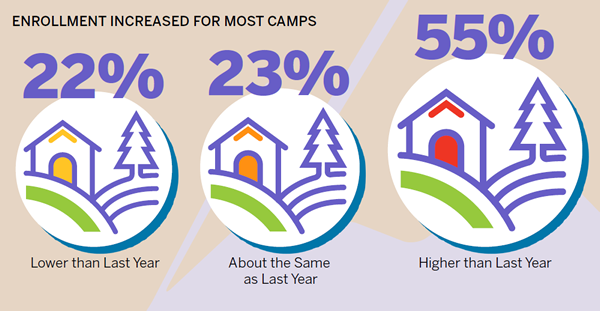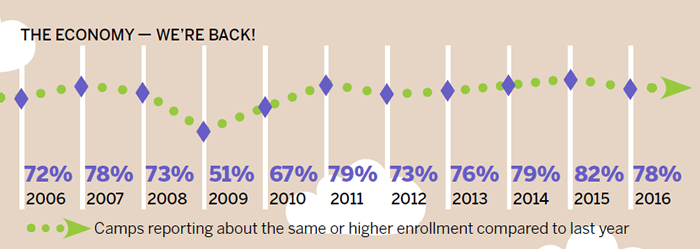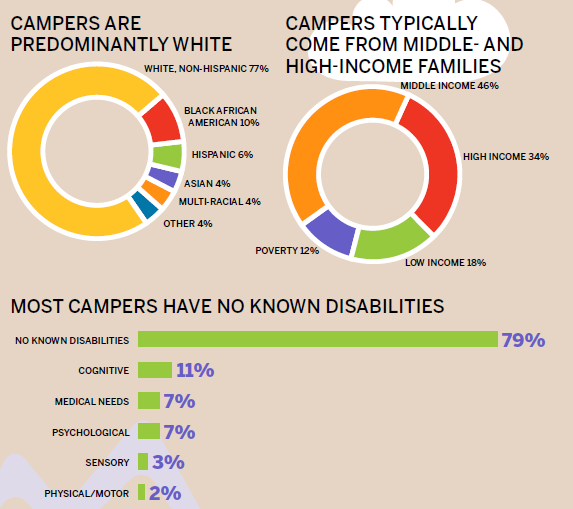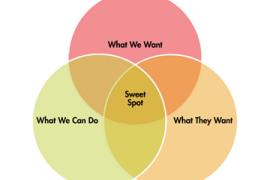The results from the 2016 Enrollment Survey are in, and here's the bottom line: Camps had a good year as enrollment continued to rise. The majority of camps reported at least maintaining the same enrollment numbers compared to 2015, and, in many cases, they were higher. This enrollment trend is a sign we have recovered from the economic recession, but with strong enrollment comes new challenges. Camps now face issues with capacity, competition, and diversity.
Camp professionals who responded to the survey represented the overall ACA membership. A total of 311 camp directors responded anonymously to the 64-question survey that was available through ACA Now from September 2 to October 9, 2016. The summer camps in the sample varied in program type, ACA field offices/affiliation, and camp affiliations. The following data, charts, and graphs are based on camp directors' responses. These enrollment trends may not apply to every camp, but ACA hopes this information will help provide insight into the industry trends as a whole. Please note some percentages do not equal 100 percent due to estimation errors.
Strong Overall Enrollment Trends
Many camps saw growth in enrollment numbers in 2016. The majority of camps (55 percent) indicated their enrollment was higher than last year. When compared to day camps, overnight summer camps had significantly more camps report they had higher enrollment than in the previous year. When looking at the past five years, 43 percent of camps said their enrollment was the highest it's ever been, and 24 percent said it was higher than most summers.

The survey results also showed that campers are returning. About 90 percent of camp directors reported retention was about the same as the prior year or higher.
Still, about 22 percent of camps reported lower enrollment compared to 2015. These responses came predominantly from summer camps located in the Mid-Atlantic compared to all other regions.
The economic downturn resulted in decreased camper enrollment in 2009. Camps continued to express economic challenges in 2012 with one director citing, "Still catching up from the economy — would like to get back to pre-2008 status quo." Since 2014, enrollment has reflected the trends established before the recession.

This is great news. The top enrollment issues for camps have shifted from economic challenges to capacity issues. One camp director mentioned, "We have more campers that want to attend than we have space for." However, this trend varies across the country. For example, camps in the Mid- Atlantic region, when compared to the South and West, continued to cite the economy as a factor negatively affecting their camps' 2016 enrollment. While it is important to pay attention to regional differences, overall, camp enrollment appears to be thriving like before the economic downturn.
Enrollment is High, but Only for Some Campers
Despite positive enrollment trends, 2016 Enrollment Survey data suggests that camps continue to serve primarily white (77 percent), middle- to high-income families (80 percent), and campers with no known disabilities (79 percent). Most campers are 12 and younger (70 percent) and predominantly female (56 percent).
Compared to previous years, the percentage of campers who came from diverse backgrounds was about the same in 2016. Many camps served youth from other countries, as evidenced by the fact that 62 percent of camps hosted varying numbers of international campers. Approximately 26 percent of camps served youth who are transgender (an increase of 8 percent from 2015). About 58 percent of camps served youth who are lesbian, gay, or bisexual (a 4 percent increase from 2015), with 1 percent of campers identifying as gender nonconforming. As camps are feeling relief economically, new challenges come to the forefront with promoting diversity and better serving diverse youth at summer camp.

Top Enrollment Issues
Each year, we ask survey respondents to describe the top two enrollment issues they faced during the past summer. Many of the issues camp professionals reported for 2016 are consistent with those mentioned in past years. The most frequently mentioned issues were:
- Capacity: Many respondents described challenges related to filling up quickly, such as the inability to accommodate all of the children who wanted to attend.
- Competition: Competition from other youth programs and lower-priced camps in the area affected enrollment and recruitment. Recruiting and marketing to reach out to new campers were difficult.
- Registration: Camps had issues with parents deciding to register their children at the last minute, registering late, not filling out paperwork correctly, and canceling or allowing their children to drop out.
- Scheduling: School calendars impacted by snow days pushed school further into the summer. Some camps requested resources on school calendar legislation. ACA has outlined a public policy position.
Key Takeaways
- Across the board, enrollment was the highest of the past five years. Camps have recovered from the economic downturn and can now look toward increasing enrollment and fulfilling ACA's 20/20 vision of a commitment to serve 20 million youth by the year 2020.
- Camps continue to predominantly serve youth who are white and from middle- to high-income families. Although some diverse youth attend camp, camps could benefit by making diversity a priority when recruiting campers and staff who reflect the shifting demographics in the United States.
- Camping Magazine kicked off a social justice-themed series of articles and interviews in its September/October 2016 issue that spotlights the work camps are doing in this regard (see Social Justice and Camp — Talking About It).
- Other Camping Magazine articles highlight how to better serve diverse campers (see Attracting Diverse Staff and Campers and The Inclusion Audit: Evaluating Your Camps Effort to Include Diverse Populations).
- Camp directors have a need for marketing resources. Many camps were interested in how to promote the benefits of their ACA accreditation and the value of camp to families.
- ACA has developed marketing tools to help (see ACA Accreditation: Valuable Marketing Tools).
- Camping Magazine has included articles on marketing (see Parent Study Suggests Strategies for Effective Use of Camp Research and Search Marketing on the Web — Drive New Camper Enrollment and Alternative Businesses).
- Online courses include Marketing Essentials for the New Economy and numerous print resources are available in the ACA Bookstore.
We would like to thank each camp director who participated in the 2016 Fall Enrollment Survey. The trend information shared in this article was made possible by your willingness to participate in this study. We hope you will consider contributing your camp's information next year. The more camps that participate in the survey, the better the information we all will have to compare our individual experiences. For more information, please read the full report.
Enrollment highlights are prepared by Cait Wilson. Cait is the ACA Research Assistant and is pursuing her doctoral studies at the University of Utah.



